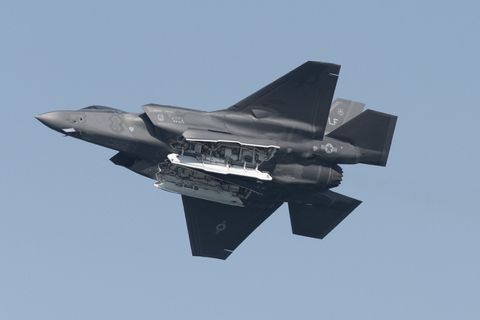BY KYLE MIZOKAMI
 The F-35, which has undergone a 20-year design and development effort, is scheduled for a slew of technology upgrades to keep the aircraft current.
The F-35, which has undergone a 20-year design and development effort, is scheduled for a slew of technology upgrades to keep the aircraft current.
The new tech should allow pilots to be more aware of their surroundings, drawing data from different sources to come up with a plan to attack the enemy.
The upgrades also include a 50 percent boost in stealthy firepower, allowing the F-35 to carry more weapons while hiding from enemy radar.
The F-35 Joint Strike Fighter is scheduled to receive a long list of upgrades that will ideally keep it the dominant multi-role fighter for years to come.
The F-35, already in service with nine countries, is scheduled to receive the new Block 4 series of enhancements in the near future. Block 4 aircraft will boast faster computers, more missiles, panoramic cockpit display, longer ranges, and AI-flown wingmen. The result is a strikingly different aircraft than the one that was originally designed in the early 2000s.
Aviation Week & Space Technology has published a rundown of the upcoming Block 4 upgrades. Rather than one large monolithic refresh, Block 4 will be released in waves, with a Block 4.1, 4.2, and so on. That way, the new capabilities will go out to the global fleet of F-35s faster, and the fighters won't have to wait for more difficult capabilities to mature.
STRAIGHT FROM THE COCKPIT
The most important Block 4 upgrade is arguably the computing power. The F-35 is set to receive new main computers capable of 25 times more instructions than current onboard computers. The result is an aircraft capable of drawing data from other friendly air, land, and sea sources in order to give the pilot a more information-packed view of the battlefield. The extra juice should also give the F-35 increased electronic warfare capabilities, allowing it to quickly jam enemy radar and radio signals.
The new “Sidekick” missile launch system is another big update. The F-35 can only carry four AIM-120 AMRAAM medium range air-to-air missiles while preserving its stealthy profile. The jet can carry even more bombs and missiles externally on wing-mounted rails, but doing so makes it a bigger target on enemy radars. The Sidekick, then, squeezes two more AMRAAM missiles into the existing belly-mounted missile bay, for a total of six AMRAAMs.
The F-35 will also eventually carry the new, longer-range AIM-260 missile currently under development, plus a new missile designed to chase down and destroy ground-based radars.
Other upgrades wait in the wings. A new wing-mounted fuel tank system should increase the F-35’s range by 25 percent, giving it a combat range of about 737 miles at the cost of greater radar visibility. The U.S. Air Force’s Skyborg program is set to develop semi-disposable “wingmen” that will fly alongside F-35s, providing everything from increased firepower to a decoy meant to lure away enemy air-to-air missiles.
No comments:
Post a Comment